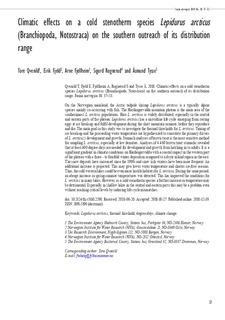| dc.contributor.author | Qvenild, Tore | |
| dc.contributor.author | Fjeld, Eirik | |
| dc.contributor.author | Fjellheim, Arne | |
| dc.contributor.author | Rognerud, Sigurd | |
| dc.contributor.author | Tysse, Åsmund | |
| dc.date.accessioned | 2019-05-14T09:17:19Z | |
| dc.date.available | 2019-05-14T09:17:19Z | |
| dc.date.created | 2019-02-18T16:11:44Z | |
| dc.date.issued | 2018 | |
| dc.identifier.citation | Fauna Norvegica. 2018, 38, 37-53. | nb_NO |
| dc.identifier.issn | 1502-4873 | |
| dc.identifier.uri | http://hdl.handle.net/11250/2597531 | |
| dc.description.abstract | On the Norwegian mainland, the Arctic tadpole shrimp Lepidurus arcticus is a typically alpine species mainly co-occurring with fish. The Hardangervidda mountain plateau is the main area of the southernmost L. arcticus populations. Here L. arcticus is widely distributed, especially in the central and eastern parts of the plateau. Lepidurus arcticus has a univoltine life cycle emerging from resting eggs at ice break-up and fulfil development during the short mountain summer, before they reproduce and die. The main goal in this study was to investigate the thermal thresholds for L. arcticus. Timing of ice break-up and the proceeding water temperature are hypothesized to constitute the primary drivers of L. arcticus's development and growth. Stomach analyses of brown trout is the most sensitive method for sampling L. arcticus, especially at low densities. Analyses of 4 460 brown trout stomachs revealed that at least 400 degree-days are needed for development and growth from hatching in to adults. It is a significant gradient in climatic conditions on Hardangervidda with a coastal impact in the western part of the plateau with a three - to fourfold winter deposition compared to a dryer inland region in the east. The snow deposits have increased since the 1980s and snow rich winters have been more frequent. An additional increase is projected. This may give lower water temperature and shorter ice-free seasons. Thus, the cold western lakes could be even more hostile habitats for L. arcticus. During the same period, an abrupt increase in spring-summer temperatures was detected. This has improved the conditions for L. arcticus in many lakes. However, as a cold stenotherm species a further increase in temperature may be detrimental. Especially in shallow lakes in the central and eastern parts this may be a problem even without reaching critical levels by inducing life cycle mismatches. | nb_NO |
| dc.language.iso | eng | nb_NO |
| dc.publisher | NTNU Open Access Journals | nb_NO |
| dc.rights | Navngivelse 4.0 Internasjonal | * |
| dc.rights.uri | http://creativecommons.org/licenses/by/4.0/deed.no | * |
| dc.title | Climatic effects on a cold stenotherm species Lepidurus arcticus (Branchiopoda, Notostraca) on the southern outreach of its distribution range | nb_NO |
| dc.type | Journal article | nb_NO |
| dc.type | Peer reviewed | nb_NO |
| dc.description.version | publishedVersion | nb_NO |
| dc.source.pagenumber | 37-53 | nb_NO |
| dc.source.volume | 38 | nb_NO |
| dc.source.journal | Fauna Norvegica | nb_NO |
| dc.identifier.doi | 10.5324/fn.v38i0.2598 | |
| dc.identifier.cristin | 1678468 | |
| cristin.unitcode | 7464,30,12,0 | |
| cristin.unitname | Akvatiske miljøgifter | |
| cristin.ispublished | true | |
| cristin.fulltext | original | |
| cristin.qualitycode | 1 | |

